Abstract
In recent years, more attention has been given to the mechanism of disease induction caused by the surface properties of minerals. In this respect, specific research needs to be focused on the biologic interactions of oxygen radicals generated by mineral particles resulting in cell injury and DNA damage leading to fibrogenesis and carcinogenesis. In this investigation, we used electron spin resonance (ESR) and spin trapping to study oxygen radical generation from aqueous suspensions of freshly fractured crystalline silica. Hydroxyl radical (.OH), superoxide radical (O2.-) and singlet oxygen (1O2) were all detected. Superoxide dismutase (SOD) partially inhibited .OH yield, whereas catalase abolished .OH generation. H2O2 enhanced .OH generation while deferoxamine inhibited it, indicating that .OH is generated via a Haber-Weiss type reaction. These spin trapping measurements provide the first evidence that aqueous suspensions of silica particles generate O2.- and 1O2. Oxygen consumption measurements indicate that freshly fractured silica uses molecular oxygen to generate O2.- and 1O2. Electrophoretic assays of in vitro DNA strand breakages showed that freshly fractured silica induced DNA strand breakage, which was inhibited by catalase and enhanced by H2O2. In an argon atmosphere, DNA damage was suppressed, showing that molecular oxygen is required for the silica-induced DNA damage. Incubation of freshly fractured silica with linoleic acid generated linoleic acid-derived free radicals and caused dose-dependent lipid peroxidation as measured by ESR spin trapping and malondialdehyde formation. SOD, catalase, and sodium benzoate inhibited lipid peroxidation by 49, 52, and 75%, respectively, again showing the role of oxygen radicals in silica-induced lipid peroxidation.(ABSTRACT TRUNCATED AT 250 WORDS)
Full text
PDF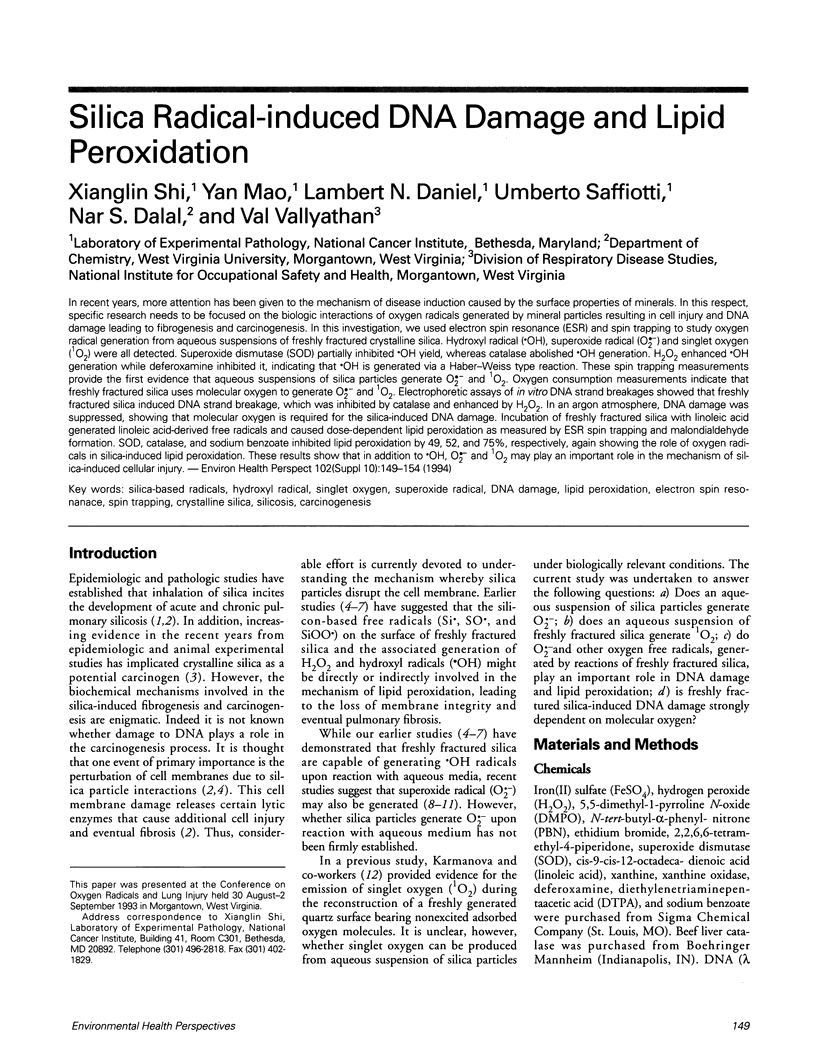
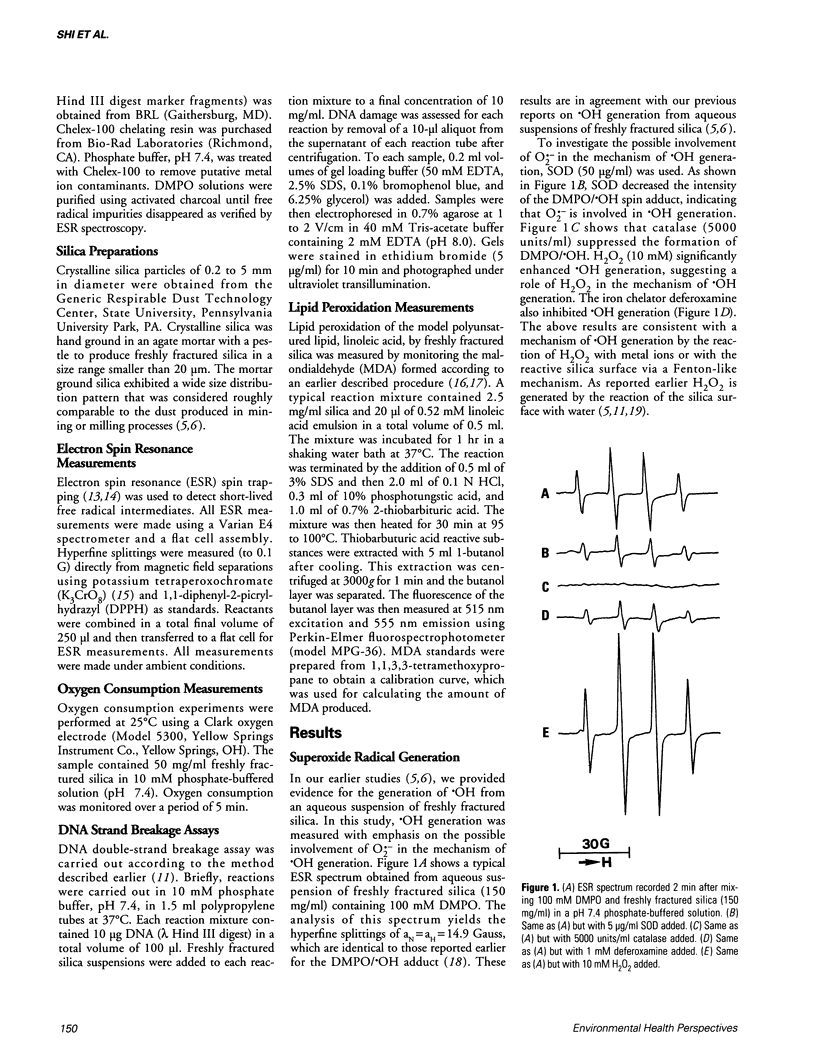
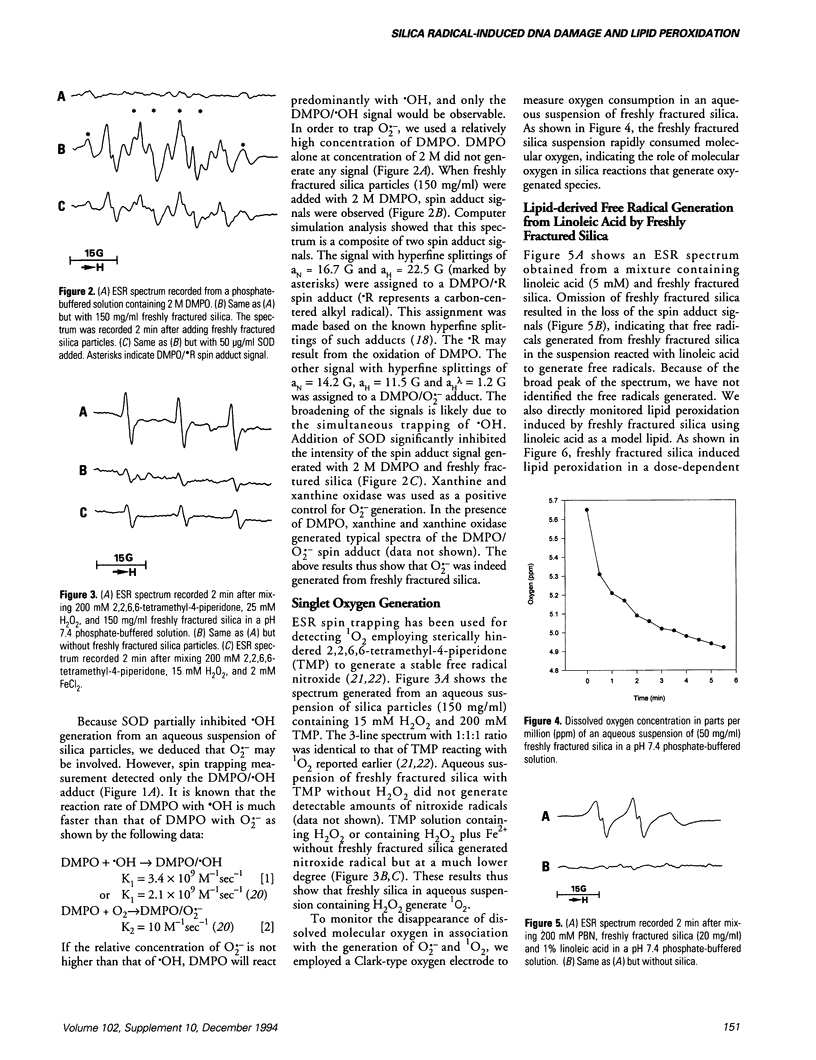
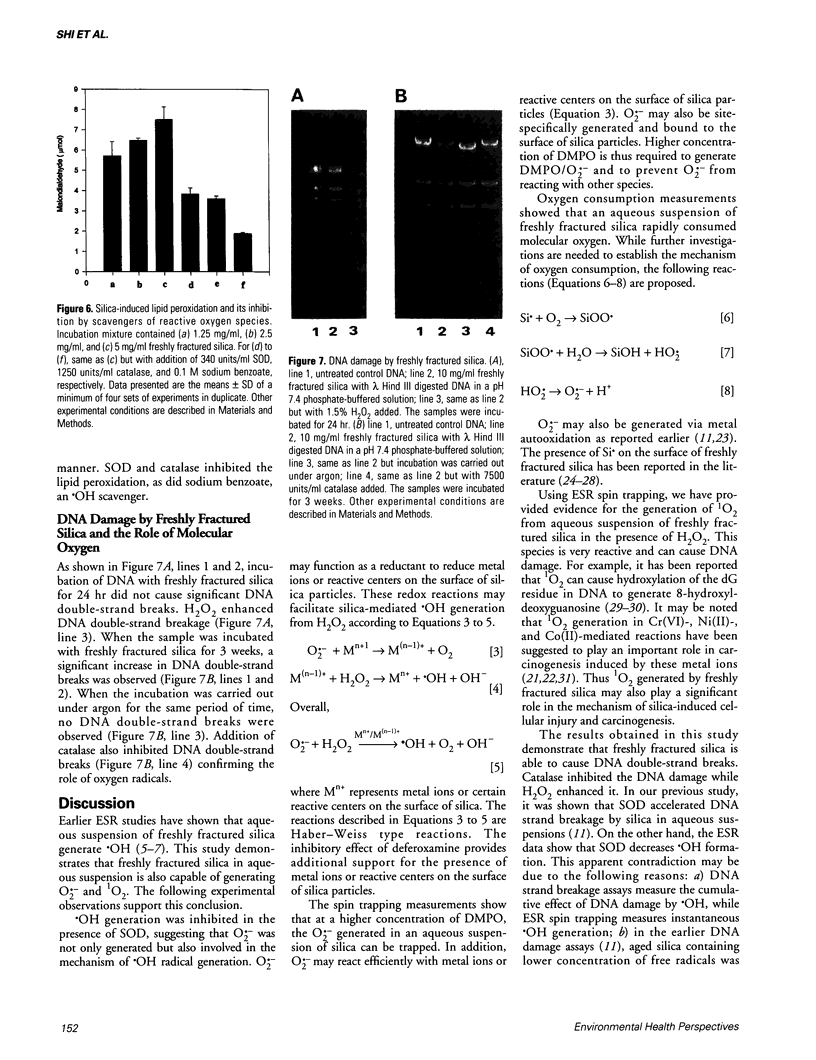
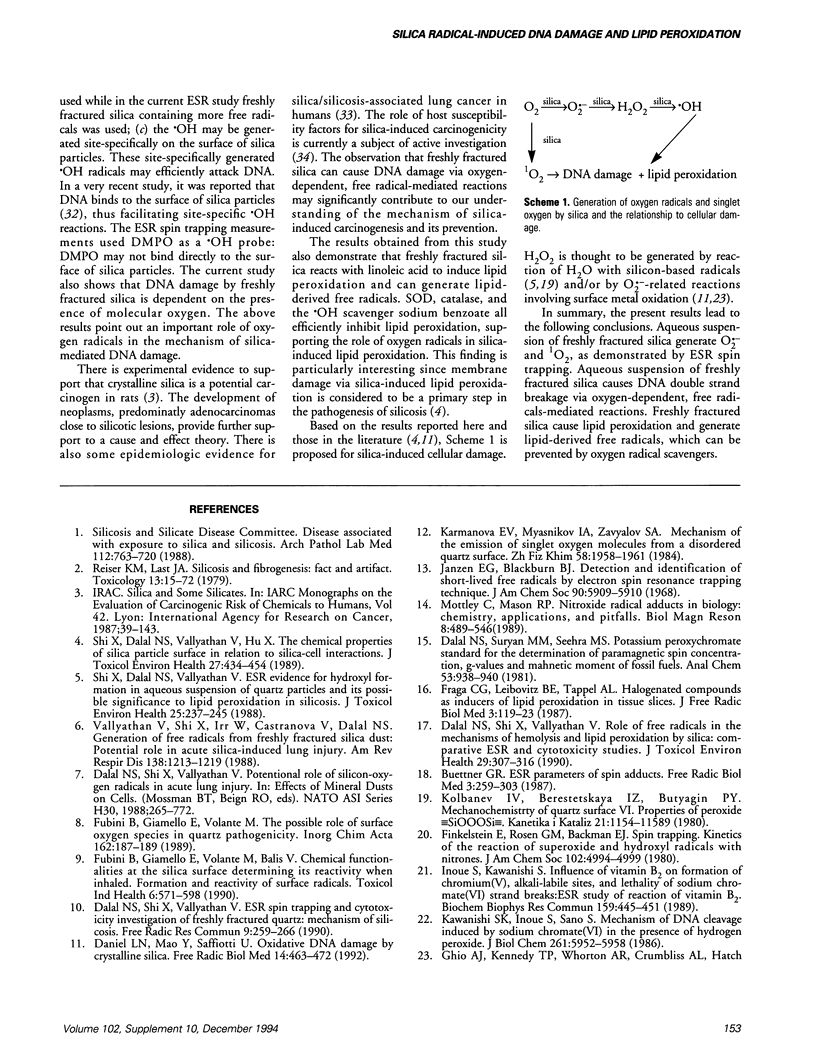
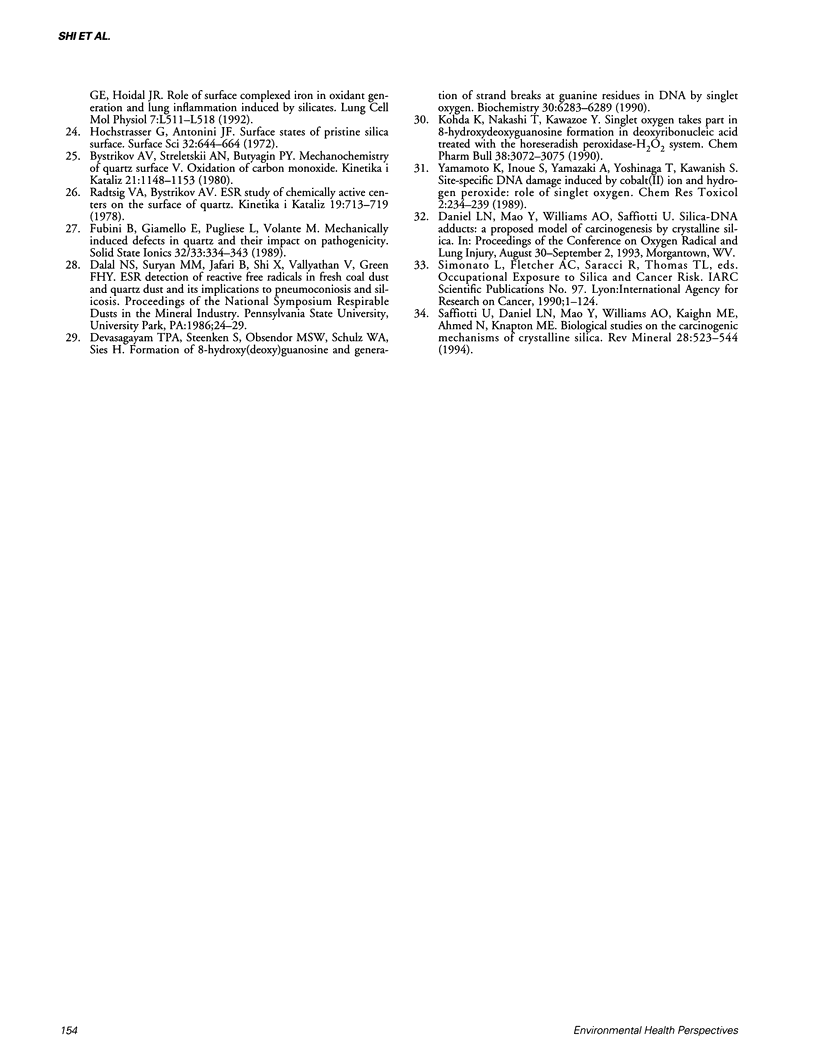
Images in this article
Selected References
These references are in PubMed. This may not be the complete list of references from this article.
- Buettner G. R. Spin trapping: ESR parameters of spin adducts. Free Radic Biol Med. 1987;3(4):259–303. doi: 10.1016/s0891-5849(87)80033-3. [DOI] [PubMed] [Google Scholar]
- Dalal N. S., Shi X. L., Vallyathan V. ESR spin trapping and cytotoxicity investigations of freshly fractured quartz: mechanism of acute silicosis. Free Radic Res Commun. 1990;9(3-6):259–266. doi: 10.3109/10715769009145684. [DOI] [PubMed] [Google Scholar]
- Dalal N. S., Shi X. L., Vallyathan V. Role of free radicals in the mechanisms of hemolysis and lipid peroxidation by silica: comparative ESR and cytotoxicity studies. J Toxicol Environ Health. 1990;29(3):307–316. doi: 10.1080/15287399009531393. [DOI] [PubMed] [Google Scholar]
- Daniel L. N., Mao Y., Saffiotti U. Oxidative DNA damage by crystalline silica. Free Radic Biol Med. 1993 May;14(5):463–472. doi: 10.1016/0891-5849(93)90103-2. [DOI] [PubMed] [Google Scholar]
- Devasagayam T. P., Steenken S., Obendorf M. S., Schulz W. A., Sies H. Formation of 8-hydroxy(deoxy)guanosine and generation of strand breaks at guanine residues in DNA by singlet oxygen. Biochemistry. 1991 Jun 25;30(25):6283–6289. doi: 10.1021/bi00239a029. [DOI] [PubMed] [Google Scholar]
- Fraga C. G., Leibovitz B. E., Tappel A. L. Halogenated compounds as inducers of lipid peroxidation in tissue slices. Free Radic Biol Med. 1987;3(2):119–123. doi: 10.1016/s0891-5849(87)80006-0. [DOI] [PubMed] [Google Scholar]
- Fubini B., Giamello E., Volante M., Bolis V. Chemical functionalities at the silica surface determining its reactivity when inhaled. Formation and reactivity of surface radicals. Toxicol Ind Health. 1990 Dec;6(6):571–598. [PubMed] [Google Scholar]
- Inoue S., Kawanishi S. ESR evidence for superoxide, hydroxyl radicals and singlet oxygen produced from hydrogen peroxide and nickel(II) complex of glycylglycyl-L-histidine. Biochem Biophys Res Commun. 1989 Mar 15;159(2):445–451. doi: 10.1016/0006-291x(89)90012-0. [DOI] [PubMed] [Google Scholar]
- Kawanishi S., Inoue S., Sano S. Mechanism of DNA cleavage induced by sodium chromate(VI) in the presence of hydrogen peroxide. J Biol Chem. 1986 May 5;261(13):5952–5958. [PubMed] [Google Scholar]
- Kohda K., Nakagawa T., Kawazoe Y. Singlet oxygen takes part in 8-hydroxydeoxyguanosine formation in deoxyribonucleic acid treated with the horseradish peroxidase-H2O2 system. Chem Pharm Bull (Tokyo) 1990 Nov;38(11):3072–3075. doi: 10.1248/cpb.38.3072. [DOI] [PubMed] [Google Scholar]
- Reiser K. M., Last J. A. Silicosis and fibrogenesis: fact and artifact. Toxicology. 1979 May;13(1):51–72. [PubMed] [Google Scholar]
- Shi X. L., Dalal N. S., Hu X. N., Vallyathan V. The chemical properties of silica particle surface in relation to silica-cell interactions. J Toxicol Environ Health. 1989;27(4):435–454. doi: 10.1080/15287398909531314. [DOI] [PubMed] [Google Scholar]
- Shi X. L., Dalal N. S., Vallyathan V. ESR evidence for the hydroxyl radical formation in aqueous suspension of quartz particles and its possible significance to lipid peroxidation in silicosis. J Toxicol Environ Health. 1988;25(2):237–245. doi: 10.1080/15287398809531205. [DOI] [PubMed] [Google Scholar]
- Vallyathan V., Shi X. L., Dalal N. S., Irr W., Castranova V. Generation of free radicals from freshly fractured silica dust. Potential role in acute silica-induced lung injury. Am Rev Respir Dis. 1988 Nov;138(5):1213–1219. doi: 10.1164/ajrccm/138.5.1213. [DOI] [PubMed] [Google Scholar]
- Yamamoto K., Inoue S., Yamazaki A., Yoshinaga T., Kawanishi S. Site-specific DNA damage induced by cobalt(II) ion and hydrogen peroxide: role of singlet oxygen. Chem Res Toxicol. 1989 Jul-Aug;2(4):234–239. doi: 10.1021/tx00010a004. [DOI] [PubMed] [Google Scholar]



